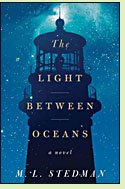The Light Between Oceans
by M.L. Stedman
Reviewed by Margaret Donsbach

The Light Between Oceans imagines a wrenching moral predicament. What if, after suffering repeated miscarriages, a woman who yearns for a child has the opportunity to rescue and raise a foundling - provided she doesn't ask too many questions about the baby's origin? In this lucidly written novel set in the 1920s, a lighthouse keeper's wife begs her husband not to report his discovery of a boat containing a dead man and a live baby. On an island off the western coast of Australia, accessible only by the supply boat which comes every three months, it's easy to omit mention of another miscarriage and pretend the baby is their own.
The point of view moves among several characters, but the central focus is on the husband. Having fought in the World War I trenches, he has memories he keeps to himself. He suffers from the guilt of surviving his fellow soldiers and of knowing he has killed. Working on a remote island helps him set the past aside; attending to the many details of his work, from maintaining the lighthouse mechanisms to keeping an accurate log, helps him rebuild a sense of himself as honorable. If the love of his wife and the foundling are healing, his lapse in the performance of his duties and his fear that, somewhere, the child's birth mother must be grieving weigh on his already-burdened conscience. The foreshadowing in this novel is not heavy-handed, but the mystery of the baby's origin suggests more anguish is in store for this couple. To say more would be to say too much.
The Light Between Oceans challenges readers to imagine what they would do in similar circumstances. If we live in a world largely made, even wrecked, by others, what are our responsibilities as we pick our way through a wreckage we can mend only in bits and pieces, and where the mending itself must cause further damage? (2012; 343 pages)
More about The Light Between Oceans at Powell's Books or Amazon.comOther novels about lighthouse keepers:
The Woman at the Light by Joanna Brady (2012), about a woman who must take over her husband's duties as lighthouse keeper on an island off Key West after he vanishes in 1839, and the runaway slave who appears on the island. More info
The Edge of the Earth by Christina Schwarz (2013), about a woman who becomes a lighthouse keeper with her husband on California's Big Sur coast in 1898. More info
Walk Across the Sea by Susan Fletcher (2001), a novel for teens about the fifteen-year-old daughter of a California lighthouse keeper who begins a tentative, secret friendship with a Chinese immigrant boy in the 1880s. More info
Nonfiction about lighthouses:
Lighting the Coast: A History of New Zealand's Coastal Lighthouse System by Helen Beaglehole (2006). More info
Guardians of the Lights: Stories of U.S. Lighthouse Keepers by Elinor DeWire (1995, revised 2007). More info
The Lighthouse Keeper's Daughter: The Remarkable True Story of American Heroine Ida Lewis by Leno Skomal (2010). More info
Online:
Lighthouses of Australia, the website of a nonprofit organization dedicated to preserving the historic lighthouses of Australia
Back to Directory of Book Reviews